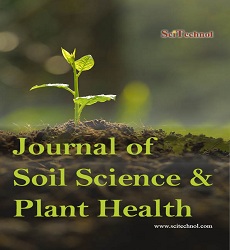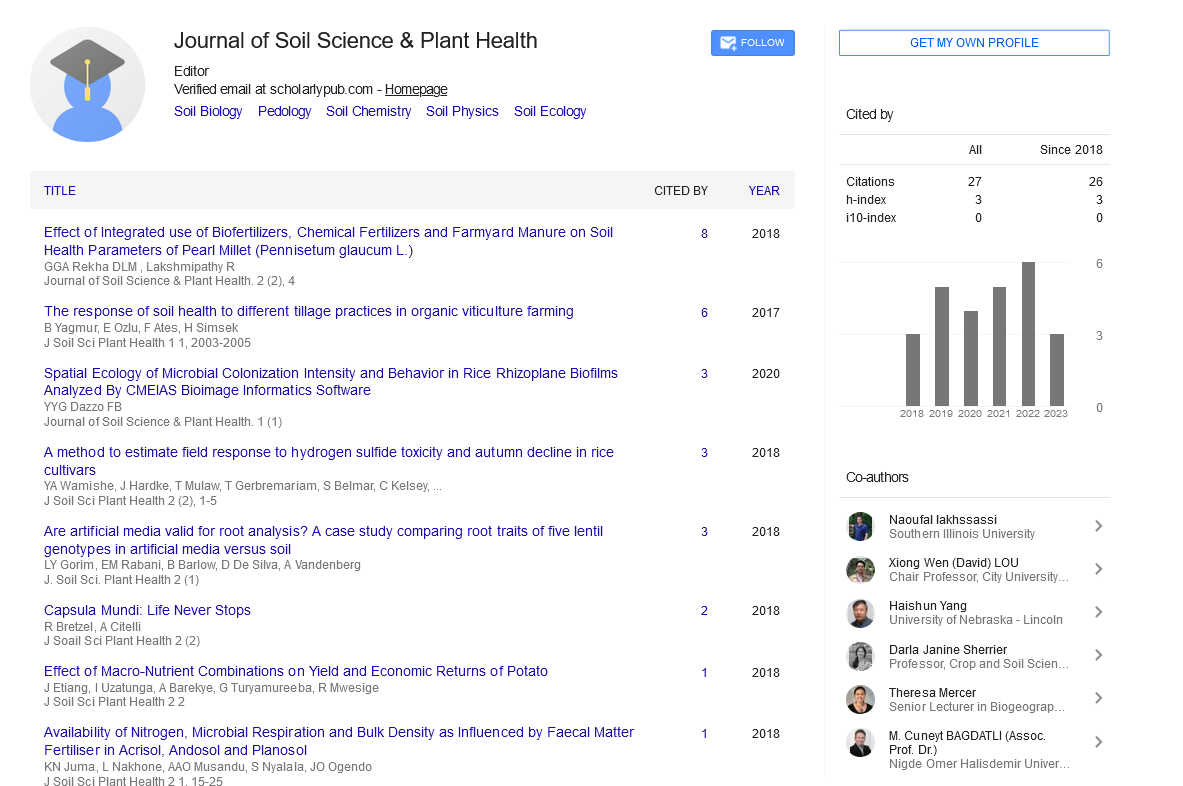About the Journal

Journal of Soil Science and Plant Health is an international, peer reviewed journal that publishes original research papers addressing soil sciences and plant biology. The Journal presents a comprehensive evaluation of the effect of anthropogenic and agricultural practices on soil properties and, further, on the mechanism of plant adaptation and plant growth.
Journal of Soil Science and Plant Health welcomes submissions that explore the interference of soil and plant sciences. Scope of journal is not merely delimited with specific keywords but for convenience to authors, here we included some key areas of research:
Submit manuscripts at Online Submission System or an e-mail attachment to the Editorial Office at manuscript@scitechnol.com
- Soil Biology
- Pedology
- Soil Chemistry
- Soil Physics
- Soil Ecology
- Plant-Soil Interactions
- Hydropedology
- Soil Fertility and Plant Nutrition
- Agricultural Soil Science
- Mineral Nutrition & Sustainable Management
- Soil Erosion and its Control
- Soil Conservation – Models, Tools and Techniques
- Fundamental and Applied Aspects of Soil Ecology
Journal strictly follows the peer-review process for unbiased evaluation and publication. The Editorial Manager System helps in maintaining the quality of the peer review process and facilitates the authors to track the process of manuscript evaluation and publication. All the submitted manuscripts undergo peer review by the subject matter experts under the guidance of the Editor-in-Chief or assigned Editorial member of the Journal.
Soil Genesis
Soil is the upper layer of the earth's crust. The major constituents of soil are mineral material, organic material, water and air. In Greek terminology, soil means ‘earth’ and genesis means ‘origin’. The definition of ‘soil genesis’ is the formation of soil. Major factors that involve in the soil formation are parental material, climate, soil organisms, time and topography of the soil. The diversity of soils is due to the difference in the soil forming processes. Ecosystem, environmental and climatic changes occurred and the arrays of physical, chemical and biological reactions influence the soil formation.
Soil Minerals
Soil minerals are the major potential sites for storage of nutrients and maintaining the soil fertility. Soil mineral material that imparts the texture and influence the water and nutrient holding capacity of soil is sand, silt and clay. In addition, the organic layer of soil is constituted by the leaves and other organic materials. Improper absorption of minerals (Nitrates, Phosphates, Potassium and Magnesium) by plant roots results in decrease of chlorophyll content, photosynthesis and respiration in plants.
Soil Pathogens
Soil microbes that cause diseases in plants, humans and animals are called soil pathogens. Invasive soil pathogens affect the useful soil microbial communities and limit the plant growth and performance. The three important groups of microbes have strongest effects on composition and functioning of the ecosystem are soil pathogens (Fungi, bacteria and viruses), soil pathogenic parasites (Nematodes), mutualistic symbionts and decomposers..
Soil Contaminants
Soil contamination is a major threat to soil due to the xenobiotic (human-made) industrial, agricultural chemicals and other improper waste disposal causing the alternation in the natural soil mechanism and environment of the soil. These contaminants have longer half-lives typically alters the soil microbiota involved in the plant metabolic activities.
Soil Management
Soil management is the eco-friendly methods to increase the soil usability and nutrient cycling by plants further decreasing the alterations caused by the soil contaminants. Some of the methods are adding organic matter, avoiding excessive tillage practices and soil compaction, pest and nutrient management, covering the ground, increasing diversity and monitoring soil performance. Application of healthy management practices benefit to enhance soil nutrients, biodiversity and biomass.
Soil Conservation
The definition of soil conservation is the prevention of soil loss from undergoing adverse effects caused by humans and natural calamities. Recommended soil conservation practices are counter plowing, terrace or keyline design farming, perimeter runoff control, windbreaks, cover crop/crop rotation, soil-conservation farming, salinity management, mineralization and use of useful soil organisms. It is a combination of modern tools with sustainable and profitable practices that helps the farmer to restore the natural health of soil required for plants.
Soil Water Plant Relationships
Physical properties of soil (composition, texture, structure, bulk density and porosity) and water cycle play a key role in maintaining the soil water plant relationship. Changes in the soil water are regulated by infiltration, water holding capacity of the soil and drainage or percolation of the soil. The relationship is essential for the better plan and management of plants to grow and adjust various environmental conditions of the soils.
Soil Biotechnology (SBT)
Soil Biotechnology is defined as the study of manipulating the soil microbial flora and their metabolic activities for conservation and remediation of the soils. It is the emerging area of biotechnology with a major focus on use of soil microbes in improving the physical properties of the soil, availability of nutrients to plants, degradation of xenobiotic and other wastes, controlling the soil-born plant pathogens, increasing the plant health and protecting the natural ecosystem. Identification and development of new microbial agents for biological control of plant pests, modification of plant pathogens for reduced virulence and bioremediation of soil is the revolutionizing aspect of biotech industries.
Plant and Soil
It is an interphase of soil sciences and plant biology, and that important in understanding the interactions of plant and soil. The interactions include different fundamental aspects of root anatomy and morphology, mineral nutrition in plants, plant-water relations, soil biology and ecology.
Plant Nutrients
Macro and micro nutrients are essential for the plant growth and development. Macronutrients required in larger quantities by plants include nitrogen, phosphorus, potassium, calcium, sulfur, magnesium and sodium. Micro nutrients or trace elements consumed in less amount constitutes boron, chlorine, manganese, iron, zinc, copper, molybdenum, nickel and cobalt.
Plant Fertilizers
Fertilizers are the nutrient compound which helps in the growth and development of plants. In addition, they enhance the water retention capacity and aeration of the soil. The utilization of fertilizers depends on the fertility of the soil. Optimal usage of fertilizers helps in maintaining the natural microbial flora and plant growth. Addition of Rhizobium and other endomycorrhizal fungi along with the NPK fertilizers in normal cultivation methods increases plant yield and promote soil and plant health.
Plant Microbes
Plant microbes can be useful or harmful microorganisms depend on plants for their growth and survival. Pathogenic, symbiotic and associative interactions are found in plants. Efficient and beneficial plant-microbe interactions are required for the stress tolerance, disease resistance and plant productivity. Isolation characterization of potential plant microbes is necessary for biological control of different plant diseases.
Plant-Pathogen Interactions
The interactions between the plant host and its pathogens (bacteria, fungi, viral, oomycetes and nematodes) are described as plant-pathogen interactions. Advanced genetic and statistical methods are followed for the development of disease resistant plants. Most studied plant pathogens of bacteria (Pseudomonas syringae, Xanthomonas campestris), fungi (Colletotrichum destructivum, Botrytis cinerea, Golovinomyces orontii), oomycete (Hyaloperonospora spp.), Viral (Cauliflower mosaic virus (CaMV), tomato mosaic virus (TMV)) and nematode (Meloidogyne incognita, Heterodera schachtii).
Plant Fungal Association
The positive mutualistic association between plant and fungal communities is essential for growth and enhancing the pathogen resistance of the host plants. Major potential mycorrhizal associations reported in different types of mycorrhizal fungi are arbuscular mycorrhiza, ectomycorrhiza, ericoid mycorrhiza and orchid mycorrhiza plays a key role in the dynamics of plant and soil ecosystem. Pyrosequencing analysis of the roots is one of the advanced techniques used for investigating the root-associated fungal communities.
Plant Bacterial Association
The colonization and association of useful bacteria with the plant system delivers a health growth to plant. These bacterial floras confer induced resistance, improve nitrogen fixation, plant growth (phytohormones) and facilitate the synthesis of metabolites antagonistic to harmful pathogens and parasite of plants. Plant bacterial and fungal interactions offer a unique contribution to biotechnological processes and biogeochemical cycles.
Plant Growth Promoters
Plant growth promoters enhance the plant growth and increase the plant yield. Auxins, gibberellins and cytokinins are the plant growth promoters perform all the metabolic processes in the different stages of plant growth. Natural growth promoters are produced by plants or stored in their seeds responsible for carrying all the biological processes and maintain plant health. Along with the plant hormones plant growth promoting Rhizobacteria (PGPR) is used as a biocontrol and biofertilization agent.
Healthy Plants
The major and essential requirements for growing a healthy plant are optimum temperature, pH, light, water, oxygen, mineral nutrients and soil support. A healthy plant is a prerequisite for a pollution free environment and maintaining human and animal health. Use of organically grown plant products can overcome the deleterious effects of harmful pesticides and insecticides.
Fast Editorial Execution and Review Process (FEE-Review Process):
Journal of Soil Science & Plant Health is participating in the Fast Editorial Execution and Review Process (FEE-Review Process) with an additional prepayment of $99 apart from the regular article processing fee. Fast Editorial Execution and Review Process is a special service for the article that enables it to get a faster response in the pre-review stage from the handling editor as well as a review from the reviewer. An author can get a faster response of pre-review maximum in 3 days since submission, and a review process by the reviewer maximum in 5 days, followed by revision/publication in 2 days. If the article gets notified for revision by the handling editor, then it will take another 5 days for external review by the previous reviewer or alternative reviewer.
Acceptance of manuscripts is driven entirely by handling editorial team considerations and independent peer-review, ensuring the highest standards are maintained no matter the route to regular peer-reviewed publication or a fast editorial review process. The handling editor and the article contributor are responsible for adhering to scientific standards. The article FEE-Review process of $99 will not be refunded even if the article is rejected or withdrawn for publication.
The corresponding author or institution/organization is responsible for making the manuscript FEE-Review Process payment. The additional FEE-Review Process payment covers the fast review processing and quick editorial decisions, and regular article publication covers the preparation in various formats for online publication, securing full-text inclusion in a number of permanent archives like HTML, XML, and PDF, and feeding to different indexing agencies.
 Spanish
Spanish  Chinese
Chinese  Russian
Russian  German
German  French
French  Japanese
Japanese  Portuguese
Portuguese  Hindi
Hindi 
